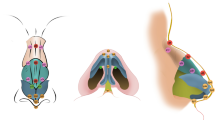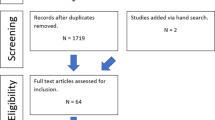Abstract
A prospective study was done to access the efficacy of ceruminolytic agents, i.e 2% paradichlorobenzene, 10% sodium bicarbonate, 2.5% acetic acid and normal saline. All score 4 hard impacted ear wax cases in the adult population (>20 years) were accrued for the assessment of the relative efficacy. Upon analyzing the comparative efficacy of four ceruminolytic agents, by taking into consideration three parameters (post) ceruminolytic cerumen score, attempts of syringing required to extrude the cerumen mass, post-ceruminolytic use and appearance of the removed cerumen mass. 2% paradichlorobenzene emerged as the most superior ceruminolytic, closely followed by 10% sodium bicarbonate. 2.5% acetic acid fared moderately while normal saline emerged as the least efficacious ceruminolytic agent.
Similar content being viewed by others
References
Freeman (1995) Impacted cerumen: How to safely remove ear wax in an office visit. Geriatrics 50:52–53
Crandwell, Roeser (1993) Incidence of excessive impacted cerumen in individuals with mental retardation: A longitudinal investigation AMJ Ment Retard 97:568–574
Zikk, Rapoport, Himelfarb (1991) Invasive external otitis after removal of impacted cerumen by irrigation. N Eng J Med 325:969–970
Lyndon, Roy, Grillage (1992) A comparison of the efficacy of two ear drop preparations (Audax & Earex) in the softening and removal of impacted earwax. Curr Med Res Opin 13:21–25
Grau (1705) Dissertatio Medica Physiologica De Cerumine. Jena
Toynbee J. (1860) Diseases of the Ear. Blanchard and Lea, Philadelphia, pp 82–87
Politzer A. (1883) Diseases of the Ear and Adjacent organs, Henry C. Lea’s Son and Co; Philadelphia, pp 580–583
Roeser, Ballachanda (1997) Physiology, pathophysiology and anthropology/epidemiology of human ear canal secretions. J. American Acad Audiol 8(6):391–400
Colin Kidd (2006) The forging of races: Race and scripture in the Protestant Atlantic World, 1600–2000: Cambridge University Press. pp 4
Carr, Smith (2001) Ceruminolytic efficacy in adults versus children. J Otolaryngol 30:154–156
Cipriani, Taborelli, Gaddia (1990) Production rate and composition of cerumen. Influence of sex and season. Laryngoscope 100:275–276
Jacobsen (1985) Age related changes in sebaceous wax ester seretion rates in men and women. J Invest Dermatology 85: 483
Chiang, Lowry, Senturia (1955) Microchemical studies on normal cerumen. I. The lipid and protein content of normal cerumen as affected by age and sex. Laryngoscope 65: 927
Matsunaga, Itoh, Suzuki and Sugimo (1954a) Incidence and inheritance of the ear wax types. Sapporo Med J 6:368
Fahmy and Whitefield (1982) Multicentre clinical trial of Exterol as a cerumenolytic. Br J Clin Pract 36:197–204
Keane, Wilson and McGrane (1995) Use of solvents to disperse ear wax Br J Clin Pract 49:71–72
Dummer, Sutherland and Murray (1992) A single -blind, randomised study to compare the efficacy of two ear drop preparations (’Audax’ and Cerumol) in the softening of ear wax. Curr Med Res Opin 13:26–30
Fraser (1970) The efficacy of wax solvents: in vitro studies and a clinical trial. J Laryngol Otol 84:1055–1064
Mehta (1985) An in vitro comparison of the disintegration of human earwax by five cerumenolytics commonly used in general practice. Br J Clin Pract 39:200–203
Robinson and Hawke (1989) The efficacy of ceruminolytics: everything old is new again. J Otolaryngol 18:263–267
Bellini, Terry and Lewis (1989) An evaluation of common ceruminolytic agents: an in vitro study. Clin Otolaryngol 14:23–25
Carr, Smith (2001) Ceruminolytic efficacy in adults versus children. J Otolaryngol 30:154–156
Hall, Colman (1975) Diseases of the external ear. In: Diseases of the Throat, Nose and Ear, 11th ed. Churchill Livingstone, London, pp 244–245
Ballantyne, Groves (1978) Miscellaneous conditions of the ear. In: A Synopsis of Otolaryngology, 3rd ed. John Wright & Sons Ltd, Bristol, pp 90–91
Mawson, Ludman (1979) Diseases due to trauma or physical agents. In: Diseases of the Ear, 4th ed. Edward Arnold, Chicago, pp 240–241
Maran (1983) Description of specific diseases of the ear. In: Otorhinolaryngology. University Park Press, Baltimore, pp 21–22
Hinchcliffe (1955) British Medical Journal 2:722
Author information
Authors and Affiliations
Corresponding author
Rights and permissions
About this article
Cite this article
Nair, P., Golhar, S., Baisakhiya, N. et al. A comparative study of ceruminolytic agents. Indian J Otolaryngol Head Neck Surg 61, 185–192 (2009). https://doi.org/10.1007/s12070-009-0063-z
Published:
Issue Date:
DOI: https://doi.org/10.1007/s12070-009-0063-z




